Mastering Minimalist Decor: Principles for a Serene & Stylish Home
Minimalism has transcended a mere design trend to become a pervasive philosophy influencing homes, offices, retail spaces, and digital interfaces worldwide. This sleek, intentional aesthetic prioritizes clean lines, open spaces, and an absence of clutter, celebrating simplicity and purpose. The undeniable allure of minimalist design has filled the interior design industry with countless minimalist decor ideas, inspiring individuals to transform their living environments.
However, true minimalism is far more nuanced than simply placing a few sparse furniture pieces against a white wall. It’s a deliberate approach to design that requires understanding its underlying principles to be executed effectively. If you’ve ever felt drawn to the tranquility and elegance of minimalist spaces but weren’t sure how to achieve it, you’re in the right place.
This comprehensive guide aims to demystify minimalist decor by explaining its foundational principles. By understanding these core concepts, you’ll gain the knowledge to fully grasp what minimalism entails and how to apply it to create harmonious, purposeful, and aesthetically pleasing environments in your own home or office.
Understanding the Core Principles of Minimalist Interior Design
At its heart, minimalism is about cultivating a life and environment filled only with items that bring meaning, value, and joy, while meticulously removing anything that serves no practical purpose or emotional connection. It’s a powerful movement towards intentional living, where the phrase “less is more” serves as the guiding mantra. By decluttering our physical spaces, we create mental clarity, allowing us to focus on what truly matters. Let’s delve into the fundamental principles that define exceptional minimalist decor.
1. Functionality is Paramount
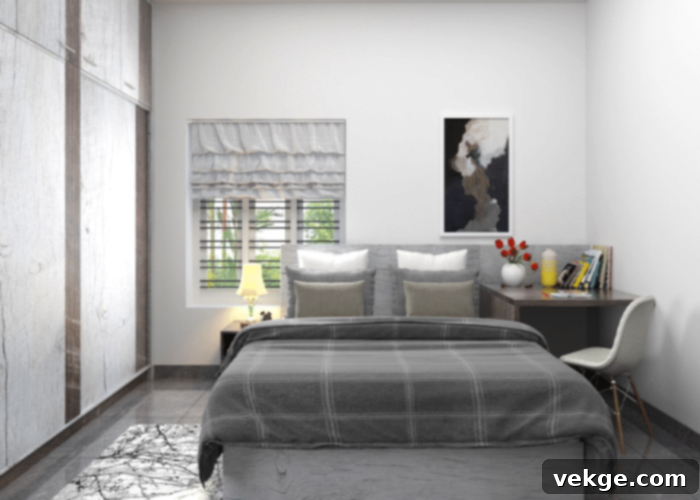
In a minimalist space, every single item serves a clear and defined purpose. There’s no room for extraneous objects or decorative clutter that simply takes up space. Furniture and furnishings are selected with meticulous thought, not just for their appearance, but primarily for their utility and how they contribute to the efficiency and flow of the room. A sofa provides comfortable seating, a dining table facilitates meals, and a desk offers a dedicated workspace. Even artwork is chosen for its ability to add aesthetic value and enhance the room’s mood without overwhelming it.
This principle extends beyond individual items; it influences the entire layout. A functional minimalist design ensures that every element, from the largest furniture piece to the smallest light fixture, contributes meaningfully to the user experience, enhancing daily routines and promoting a sense of ease and order. When everything has a purpose, clutter naturally diminishes, and the space becomes a sanctuary of intentional living.
2. Emphasize Quality Over Quantity
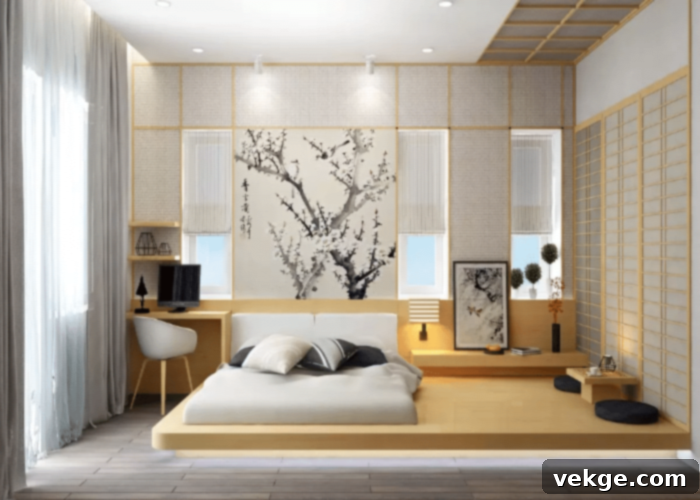
While minimalism is about owning less, it doesn’t necessarily mean spending less. In fact, it often encourages investing more in fewer, higher-quality items. The rationale is simple: well-crafted furnishings and fixtures are durable, timeless, and resilient. They are designed to last, reducing the need for frequent replacements and contributing to a more sustainable lifestyle. Instead of filling a room with many inexpensive, transient pieces, a minimalist approach advocates for selecting a few exquisite items that stand the test of time, both in terms of physical durability and aesthetic appeal.
High-quality pieces also bring a sense of luxury and sophistication to a minimalist home. Their superior craftsmanship, refined materials, and thoughtful design elevate the entire space, proving that true elegance lies in discernment, not excess. This intentional approach ensures that your decor remains beautiful and functional for years to come, reflecting a conscious choice to value substance over superficiality.
3. Embrace Diverse Textures and Materials
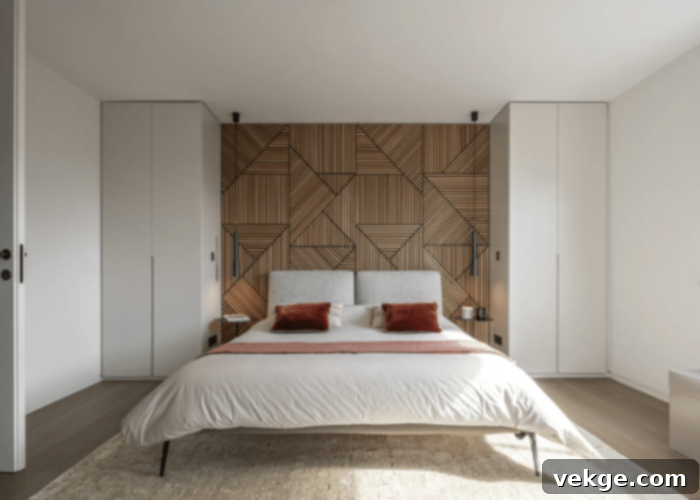
A common misconception about minimalist design is that it must be sterile or boring due to a limited color palette. While minimalist spaces often favor subtle, muted, or monochromatic color schemes over bold and loud hues, this doesn’t preclude a rich sensory experience. The secret lies in the masterful use of varied textures and materials to add depth, warmth, and visual interest without introducing additional clutter.
Imagine a living room with smooth glass surfaces, rough linen textiles, warm wooden furniture, and sleek metal accents. Each material contributes a distinct tactile and visual quality, creating a dynamic environment that engages the senses. Natural elements like stone, clay, and plants also play a crucial role, bringing organic textures and a connection to nature. This thoughtful layering of materials ensures that your minimalist home feels inviting and sophisticated, even with a restrained color palette, and can be applied seamlessly in both residential and professional settings.
4. Designate One Standout Furniture Piece

Simplicity is the cornerstone of minimalism, but it doesn’t mean foregoing personality or visual impact. In fact, a minimalist space often thrives on a single, carefully chosen focal point. This principle suggests incorporating one standout piece of furniture that commands attention and acts as the room’s anchor. This could be a uniquely shaped sofa, an elegant dining table with sculptural legs, a striking armchair, or a distinctive bed frame.
This standout piece draws the eye, allowing all other elements in the room to play a complementary, supporting role. It creates a narrative, a central theme around which the rest of the decor softly revolves, enhancing the overall design without creating visual noise. The key is to ensure this piece, while prominent, still aligns with the principles of functionality and quality, integrating seamlessly into the minimalist ethos.
5. Curate One Statement Art Piece
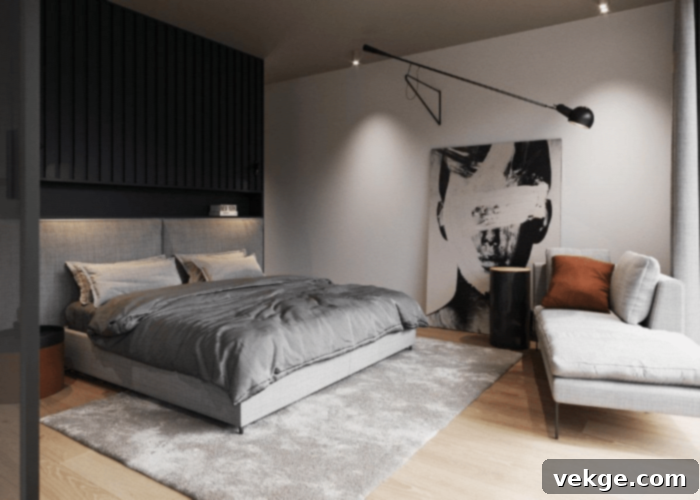
Contrary to popular belief, art finds a profound place in minimalist design. Rather than covering walls with multiple small pieces, the minimalist approach often features one large, impactful artwork. This statement piece becomes a powerful visual anchor, dominating the wall and infusing the room with personality and emotion. Its scale and presence create a strong impression, making it a natural focal point.
The beauty of this approach is that the artwork itself doesn’t have to adhere to a muted or subtle color scheme. It can be vibrant, bold, and expressive, as long as it aligns with the room’s overall aesthetic and adheres to the principles of form and function. This single, carefully chosen piece of art can introduce a burst of color, a compelling narrative, or a thought-provoking element, tying into the room’s interior design and elevating it to an artistic expression.
6. Strategic Use of Accented Elements
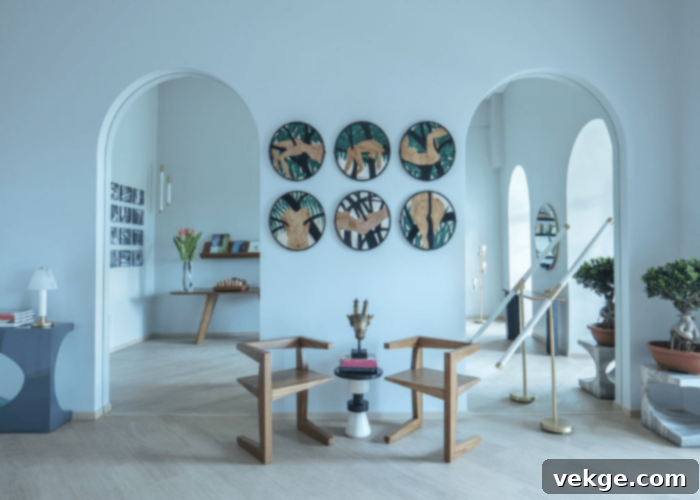
A minimalist room, while often neutral in its primary color scheme, doesn’t have to be devoid of color or excitement. The judicious inclusion of accented elements can breathe life into a space, creating unexpected visual interest and guiding the eye. These accents are typically in a contrasting color or a bold texture, strategically placed to draw attention.
Consider a predominantly neutral room with a vibrant throw pillow, a single plant with striking foliage, a textured rug, or even a feature wall painted in a deep, rich hue. These elements act as subtle surprises, preventing the space from feeling monotonous and reflecting the occupant’s personality. The key is moderation; one or two well-placed accents can make a profound impact without disrupting the overall sense of calm and simplicity that defines minimalist interior design.
7. Embrace Simple Furniture Designs
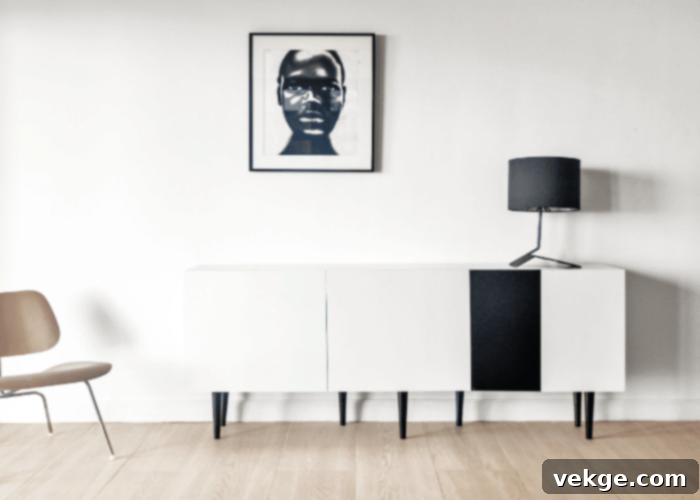
The vast array of furniture designs available today can be overwhelming, with abstract themes and complex forms dominating many showrooms. However, in minimalist decor, the focus shifts to simplicity, clean lines, and timeless aesthetics. Minimalist furniture pieces are often characterized by their understated elegance, focusing on form, function, and comfort rather than elaborate ornamentation.
Think sleek, low-profile sofas, minimalist shelving units, and tables with uncomplicated silhouettes. These pieces are designed to integrate seamlessly into the background, allowing other decor elements – like a statement art piece or an expansive view – to take center stage. Simple furniture contributes to an uncluttered visual landscape, promoting a sense of order and tranquility. It’s about choosing pieces that are both practical and aesthetically pleasing, without drawing unnecessary attention to themselves.
8. Let the View Be the Star
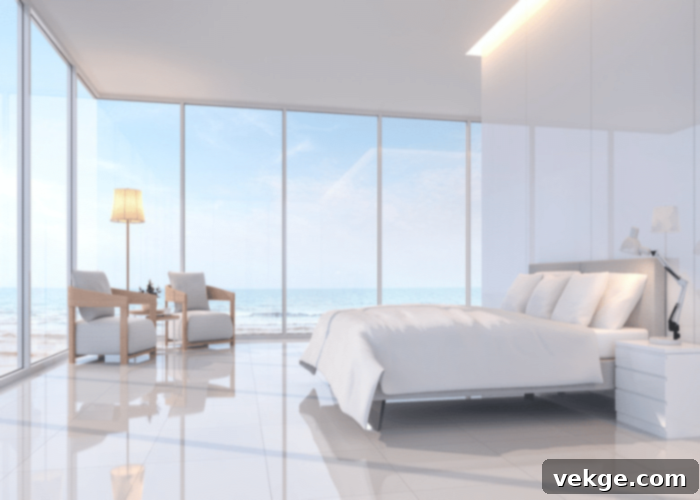
If your space is blessed with a spectacular natural view – whether it’s a cityscape, a serene garden, or a breathtaking ocean vista – minimalism offers the perfect framework to make it the ultimate centerpiece. In such fortunate scenarios, the external environment becomes an integral part of your interior design. You won’t need to over-decorate; the view itself acts as the most compelling artwork, captivating guests and creating an unparalleled sense of grandeur.
Minimalist principles dictate that when a powerful view exists, the interior decor should recede, allowing the outside world to take prominence. Simple, understated furniture, perhaps a few carefully chosen plants that echo the natural surroundings, or minimalist artwork that complements rather than competes, will suffice. The goal is to frame the view, maximize natural light, and create a seamless connection between the indoors and outdoors, making the room feel expansive and endlessly engaging.
9. Embrace the Power of Open Space
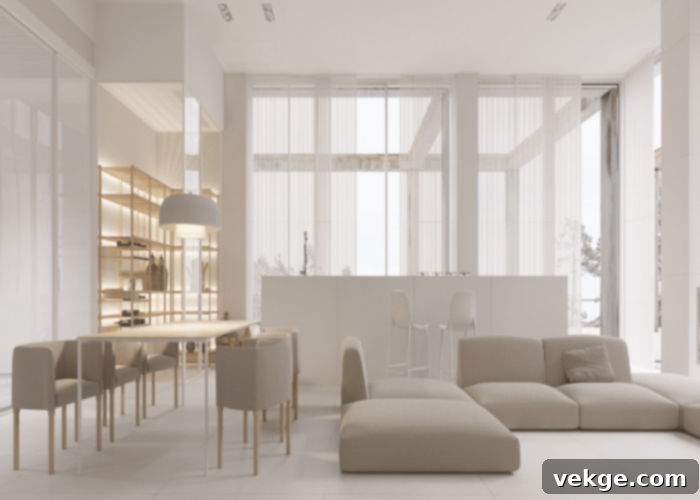
Many traditional design approaches tend to fill every available inch of a room, often leading to spaces that feel overwhelming and cluttered. In contrast, minimalism champions the concept of open space, or “negative space,” as a vital design element. Rather than viewing empty areas as voids to be filled, minimalist design celebrates them as opportunities for visual rest, flow, and psychological comfort.
By opting for minimal furniture and carefully selected decorations, you allow the inherent architecture and vastness of the room to become part of the interior design narrative. Open spaces create a sense of calm, clarity, and breathability, encouraging occupants to feel more relaxed and focused. It’s about letting the space itself speak, promoting a feeling of expansiveness and understated elegance. Don’t be afraid to leave areas intentionally empty; sometimes, the most powerful design statement is the absence of elements, allowing the mind to wander and find peace.
10. Innovative Lighting as Minimalist Decor
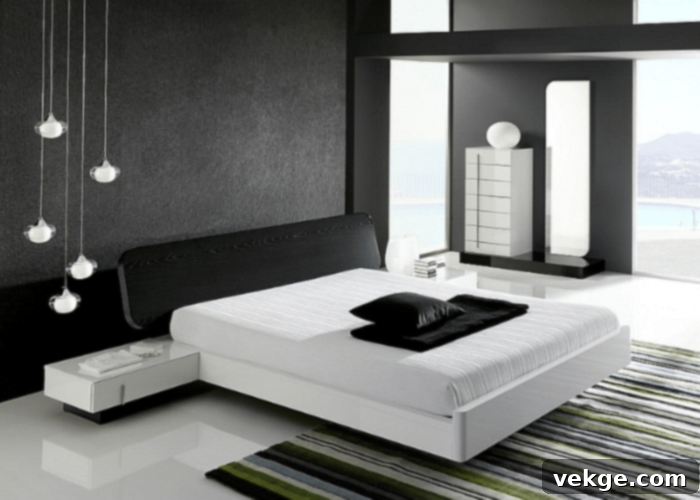
While grand chandeliers might be symbols of luxury and focal points in more opulent styles, they typically don’t align with the minimalist design approach. However, lighting plays an indispensable role in minimalist decor, not just for illumination but as a decorative and atmospheric element. Modern lighting fixtures have evolved into sophisticated works of art, offering sleek, understated, and sculptural forms that perfectly complement a minimalist aesthetic.
Think about the elegant simplicity of recessed lighting, the functional beauty of task lights, or the dramatic appeal of pendant or drop lights. These fixtures can highlight architectural features, define zones within an open-plan space, or add a subtle touch of elegance when suspended above a dining table or bedside. The strategic use of ambient, task, and accent lighting can dramatically alter the mood and functionality of a minimalist room, proving that even the most practical elements can contribute significantly to the overall design and aesthetic appeal.
Final Thoughts on Embracing Minimalist Decor
Minimalism is more than just a fleeting trend; it’s a deliberate lifestyle choice that translates into a design philosophy characterized by simplicity, intentionality, and sleekness. It’s not merely about decorating with the fewest possible pieces of furniture and furnishings, but rather about thoughtfully curating a space where every item serves a purpose and contributes to a sense of peace and harmony.
By diligently following these fundamental design guidelines for minimalist decor, you can transform any space into a spectacular sanctuary. Whether you’re contemplating a complete home renovation or just seeking to refresh your office environment, we strongly encourage you to give minimalist interior design a try. You’ll likely be amazed by the profound sense of tranquility, clarity, and beauty it brings.
Now that you’re equipped with these foundational principles and a wealth of minimalist ideas, you’re ready to embark on your next design project with confidence. We invite you to share your experiences in the comments below: Have you incorporated minimalist designs into your space? What motivated your choice of a minimalist style? Where do you apply these minimalist techniques, and what insights or tips do you think others should know about creating a truly minimalist home or office?
